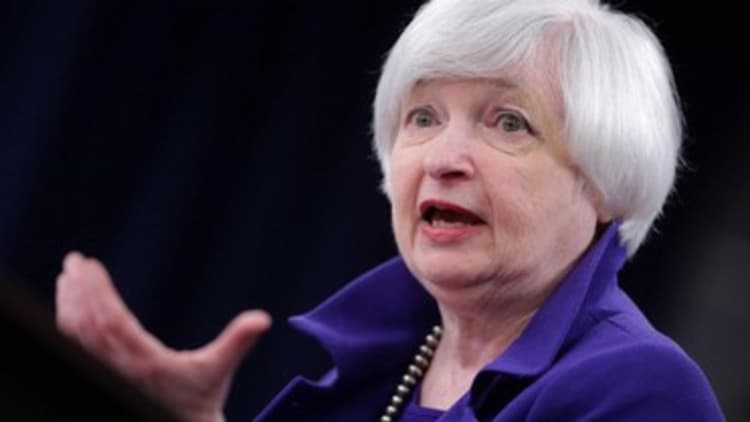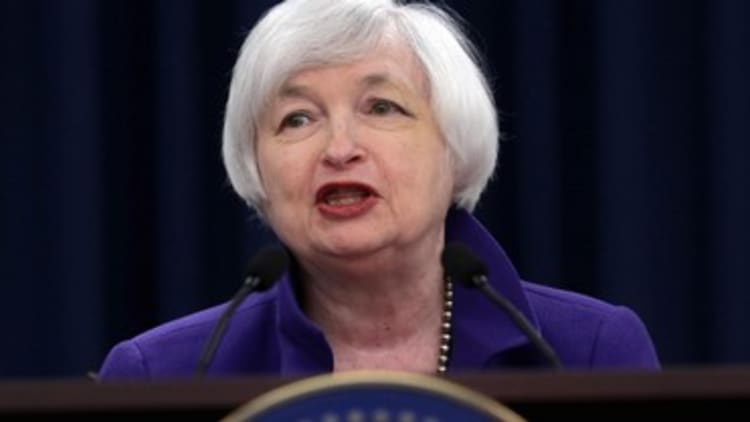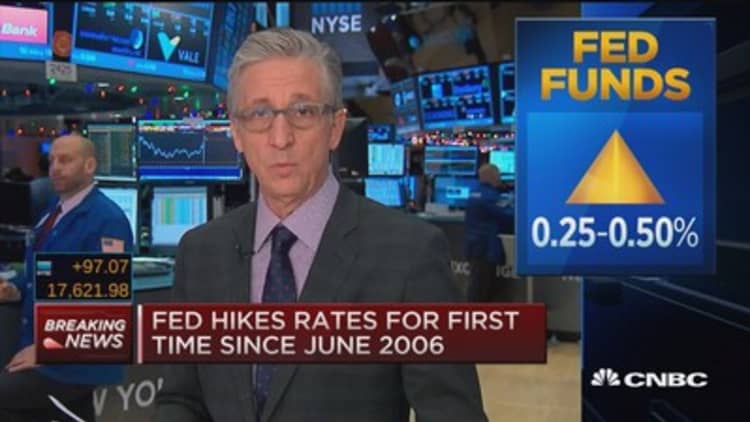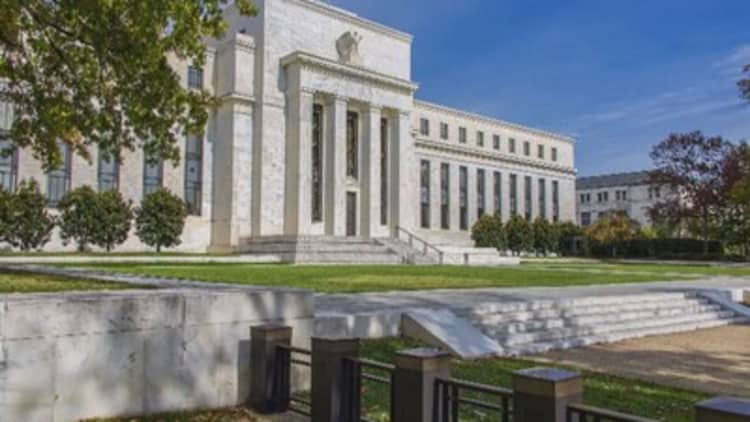At long last, a rate hike for the history books.
After seven years of the most accommodative monetary policy in U.S. history, the Fed on Wednesday, as widely expected, approved a quarter-point increase in its target funds rate. The new target will go from 0 percent to 0.25 percent to 0.25 percent to 0.5 percent. Most members expect the new rate to coalesce around 0.375 percent before the next hike, according to a chart showing individual member expectations.
The decision, given the official stamp of approval from the Federal Open Market Committee, marks the first increase since the panel pushed the key rate to 5.25 percent on June 29, 2006. In a succession of moves necessitated by the financial crisis and the Great Recession that officially ended in mid-2009, the FOMC took the rate to zero exactly seven years ago, on Dec. 16, 2008.
"Given the economic outlook, and recognizing the time it takes for policy actions to affect future economic conditions, the committee decided to raise the target range for the federal funds rate to ¼ to ½ percent," the FOMC's post-meeting statement said. "The stance of monetary policy remains accommodative after this increase, thereby supporting further improvements in labor market conditions and a return to 2 percent inflation."
There were no dissents, even though multiple FOMC members publicly over the past few months have expressed reservations about rate hikes. The committee also voted to raise the discount rate a quarter-point to 1 percent.
In addition to the usual documents released with the post-meeting statement, the Fed put out a statement outlining the mechanics of how the new rate will come to pass. The program will be ambitious, involving $2 trillion of securities that will be used in overnight trading to push the rate into the desired range. However, the FOMC statement said it will be some time before the Fed starts unwinding its mammoth $4.5 trillion balance sheet.
"The premise behind today's rate hike to me feels a little stagflationary. They didn't raise rates today because real growth got a lot stronger. In fact, if anything it got weaker, but they raised them anyway," said Jim Paulsen, chief market strategist at Wells Capital Management. "If we go through 2016 where real growth doesn't pick up but wage and price pressures do because we're in full employment, that's stagflationary."
Despite the history-making move, the road back to normalcy will be a long one. FOMC officials made it excessively clear in post-meeting documents that the pace of increases will be gradual and dependent on the quality of economic data. The projections and statement following the meeting reflected an effort to deliver the "dovish hike" many on Wall Street had been forecasting.
"The committee expects that economic conditions will evolve in a manner that will warrant only gradual increases in the federal funds rate; the funds rate is likely to remain, for some time, below levels that are expected to prevail in the longer run," the post-meeting statement said. "However, the actual path of the federal funds rate will depend on the economic outlook as informed by incoming data."
The statement also added this sentence to ensure markets that the pace will be slow: "The committee currently expects that, with gradual adjustments in the stance of monetary policy, economic activity will continue to expand at a moderate pace and labor market indicators will continue to strengthen."
The statement said the economy has expanded "at a moderate pace," just as previous statements have said. However, the statement was a bit more optimistic about labor conditions, saying slack "had diminished appreciably since early this year," with "appreciably" added from the October statement.
The closely watched "dot plot" that summarizes members' expectations for interest rates, showed only modest appetite for future hikes, with all but three members projecting the rate to be 1.5 percent or lower by the end of 2016. FOMC members now expect the funds rate to be just 2.4 percent in 2017, against a 2.6 percent projection in September. The expectation also declined for 2018, from 3.4 percent in September to 3.3 percent at this month's meeting.
"This statement is more dovish than I would've expected," said Scott Minerd, Guggenheim Partners global CIO and chairman of investments. "They've committed to keeping the balance sheet at the same size for a period of time well into tightening; I think this is a very dovish statement."
In addition to raising the funds rate, the committee pushed the interest paid on excess reserves to 0.5 percent and put the rate on overnight reverse repo operations to 0.25 percent, both in conjunction with the sale of securities that will be needed to push the rate higher.
"Not a big surprise here. So our expectation is still a flatter yield curve, firmer dollar, weaker commodity prices, a very slow and low pace of interest ... rate increases across the short end of the curve. It was definitely a dovish hike," said Kathy Jones, chief fixed income strategist at Charles Schwab.
The Fed had been holding the funds rate near zero despite a steady but unspectacular pattern of growth once the recession ended.
Both Fed chairs during the era, Ben Bernanke and Janet Yellen, the current leader, insisted the zero rate was necessary to keep the recovery going. However, the low rates, coupled with $3.7 trillion in money printing known as quantitative easing, did more to boost financial markets than the economy, which has never eclipsed a 2.7 percent annualized gain throughout the period, the worst recovery since the Great Depression.
Despite feeling it was time to hike rates, the quarterly summary of economic projections showed Fed officials had not grown substantially more optimistic about economic growth. Forecasts for gross domestic product growth were essentially unchanged since the September meeting, with a modest improvement expected in 2016 from an initially projected 2.3 percent to 2.4 percent. Expectations for inflation actually edged lower, with the core personal consumption expenditures index projected to 1.6 percent growth in 2016, down one-tenth from the September forecast.
The stock market has boomed during the period of zero rates, rising 207 percent since the March 2009 low point.
Unemployment, which is one part of the Fed's dual mandate, has fallen to 5 percent. Inflation, the other part, has been less robust, registering just 1.3 percent growth most recently.
In raising rates, the FOMC signaled the first steps to policy normalization. The target is tied to a raft of key interest rates consumers pay. Wells Fargo almost immediately announced it would increase its prime rate to 3.5 percent effective Thursday. U.S. Bancorp and JPMorgan Chase quickly followed with their own hikes.
The Fed increase came as equity markets have hit something of a wall, commodity prices have declined sharply, and market participants have begun to worry about troubles in the junk bond market. Cheap interest rates have allowed companies with lower credit quality to borrow in record numbers at low cost. However, at least three junk funds have collapsed recently, and exchange-traded funds that track the high-yield sector have suffered sharp losses.










